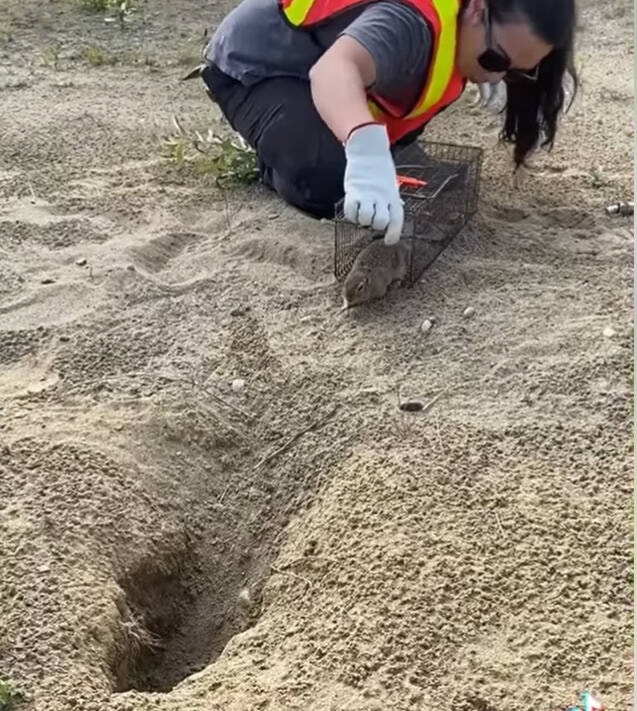Last week, the Yukon Wildlife Viewing Department worked with local students to safely relocate a colony of arctic ground squirrels whose homes were threatened by highway construction.
Safety improvements along the Alaska Highway between Lodestar Lane and the weigh scales threatened to disrupt the habitat of arctic ground squirrels — one of the pioneer species of the northern ecosystem.
The Yukon Department of Highways and Public Works notified leading biologists and the Wildlife Viewing Department with the Yukon government of the project taking place in the area, and asked if they had any concerns about local wildlife. The wildlife team were aware of a colony of arctic ground squirrels who made their homes along the side of the highway. They decided that the best solution would be to safely relocate the animals to a new burrowing site.
Tom Jung, senior biologist at the Yukon government, emphasized that burrows are essential to these animals’ survival in many regards.
The squirrels hunker down in their burrows during their long hibernation period, which is how they survive the winter. They also rely on their burrows to escape from foul weather and, most importantly, predators. Without burrows to retreat to, the squirrels are vulnerable to all sorts of predators — canids such as foxes, wolves and coyotes, as well as large aerial predators like hawks. According to the wildlife team, moving the squirrels to a habitat with pre-existing burrows was key to their survival.
“Any time you disrupt wildlife it can come as a bit of a shock to the system, and they’ll likely take a bit to recover. But because we were able to move them to an area that has burrows, they didn’t necessarily have to start from scratch,” Jung said.
The ground squirrels will have familiar neighbours to help them adjust to their new environment. Jung said the team based their methods off research, conducted by the University of British Columbia near Burwash Landing, which found that success in relocating squirrels was greatly enhanced if there were “at least a couple of squirrels already in the area.”
In choosing the new burrowing site, the wildlife team made sure there were already a few long-term resident squirrels in the area, but also plenty of unoccupied burrows.
Carrie McClelland, lead educator and outreach biologist with the Yukon government, took this opportunity to teach local students about conservation. The students accompanied McClelland on daily fieldwork, as shown on a video on Facebook posted by the Wildlife Viewing Department on July 10.
According to McClelland, the project was not only a learning opportunity for the students — their work actually made a real impact. As well as doing the hands-on work, McClelland said that the students were especially keen to film a TikTok video which documented the process.
“They got to learn about wildlife trapping and protocols and safe handling and got to do some fieldwork. They really helped us out in our busy schedules and they helped our highways, and they got to learn a lot,” McClelland said.
The process of catching and moving the squirrels took several days. In the mornings, McClelland and her students would set the traps at the entrances of the burrows, bait them with peanut butter apples, and wait for the sunlight to draw them out.
McClelland said that it took a few days for the squirrels to get used to these strange new devices in their environment; however, their curiosity eventually got the better of them. Once caught, the squirrels were transported in wire crates and introduced into their new burrows.
The timing of the project fit uniquely well with the ground squirrels’ natural hibernation cycles.
“If this were to happen a little later in the summer, then the males wouldn’t be coming out of their burrows and so we wouldn’t be able to catch them and relocate them,” Jung said.
“The males are only active about four months of the year, from April to the end of July or early August. And the rest of the year they stay in their burrow in hibernation.”
Ground squirrel pups are born in the spring, just after the males come out of hibernation. In the summer months, the pups are still following their parents around, but are also becoming more independent and beginning to venture out of their burrows — making them much easier to catch.
“We were really happy when we caught the two adults and four pups in one go, because it was great to move them as a family unit together. And that will hopefully increase the chances of survival,” McClelland said.
Jung said that if similar work were to disrupt the animals at a time of year less ideal to their natural rhythms, the Department of Highways would have to explore different methods of mitigation or even postpone the project.
Arctic ground squirrels have lived and thrived in the Yukon’s harsh climate for tens of thousands of years and were even around during the time of the mammoths. The unique biological strategies they have developed over time are what have allowed them to survive here for this long. Although ground squirrels can still be found throughout Northern Canada, Jung says that the population has certainly seen a decline over the past 20 years, especially in the Yukon.
Because the squirrels make their burrows in open habitats, they can often be found in areas that overlap with human development, such as parks, highway verges and airports, Jung predicts that habitat conflicts like this one will continue to become more common. However, he claims that the conversation around habitat sensitivity is also becoming part of standard procedure.
“Highways and Public Works and the people we worked with on this project are very sensitive to these issues and are trying to make things work in a way that doesn’t have a negative impact on wildlife,” Jung said.
Contact Mira Alden-Hull at mira.alden-hull@yukon-news.com
